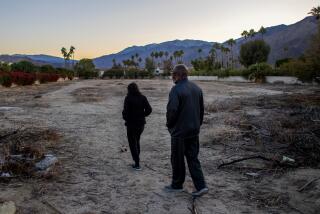Colombia law fails to put land back in farmers’ hands
VALLEDUPAR, Colombia — A Colombian law enacted in 2011 gave hope to peasant farmer Miguel Serna and hundreds of thousands of other displaced farmers like him that they would soon recover the land that rebels, right-wing paramilitaries and drug traffickers forced them to abandon during decades of armed conflict.
But such hopes have begun to fade in the face of government inaction.
“It’s a beautiful law that gave us hope we might recover our land. But we’re still in limbo and under constant threat,” said Serna, who in 1997 was forced by paramilitaries to flee his small farm in El Toco township in northern Colombia, along with dozens of his neighbors
As leader of the community’s displaced farmers, Serna has spearheaded efforts to recover the land under the Victims and Land Restitution Law. But only four families in his group of 80 have received favorable verdicts from special government land tribunals, and none has the money to clear and farm the properties, nor do they dare reoccupy them for fear of reprisal.
Civil society groups are increasingly critical of the lack of economic support and adequate security. Some warn that unless the government of President Juan Manuel Santos puts forth a comprehensive support program, the restitution initiative may be doomed.
“Violence and intimidation against displaced families attempting to return home threaten to sabotage [Santos’] banner human rights initiative,” said Jose Miguel Vivanco, Americas director at Human Rights Watch, which in September issued a critical report on restitution. “Unless Colombia starts to ensure justice for abuses against land claimants, they will continue to be killed, threatened and displaced for seeking to reclaim what’s theirs.”
Meanwhile, the ranks of Colombia’s displaced continue to grow, according to a U.N. report issued last month, adding to the government’s restitution caseload and providing an indication that violence against poor farmers continues.
After Serna and others fled the town in Cesar province, a powerful paramilitary leader aggregated the land into a single cattle ranch and had the title transferred to his name with the help of corrupt local officials, according to the landless rights group Development and Peace Program of Cesar. Aid groups here say the capo still controls the stolen land through testaferros, or stand-ins.
Confusion surrounding land titles is difficult to untangle; that’s one reason less than 2% of the 46,000 restitution claims filed as of November have been decided. And only a small number of successful claimants have dared reoccupy their land, because of possible violence, said Camilo Sanchez, a law professor and restitution expert with the DeJusticia think tank in Bogota, the capital.
Juan Manuel Rodriguez, one of the four El Toco landless who have received a favorable decision, has been assured by the government that he will receive about $12,000 in aid, but it has been months and no cash has materialized.
Serna has survived two assassination attempts, his government-provided bodyguard said, and continues to receive numerous threats. As many as 49 landless claimants have been killed in the last three years, according to the Colombian attorney general’s office.
Perpetrators include criminal bands such as the Urabenos, the largest successor armed group to paramilitaries demobilized in 2006. Their activities include land grabbing and extortion, said a high-ranking U.S. law enforcement official in Bogota who spoke on condition of anonymity.
Drug traffickers also want farmers off the land to protect smuggling routes. And the Revolutionary Armed Forces of Colombia, a left-wing rebel group, routinely forces peasants off land that lies in the path of its escape routes, the official said.
Analysts hail the victims law for its good intentions and its recognition that those who suffered from Colombia’s armed conflict deserve compensation. The law also recognizes that too much land is held in the hands of too few, President Santos has said.
“The victims law is the most important one ever passed in Colombia on restitution,” said Sanchez, the professor, who is now a visiting scholar at University of Texas at Austin.
“But it’s not enough to give farmers back their titles. They need economic support and they need protection,” Sanchez said. “The government has to decide on an overall policy on land management. Without it, the peasants can’t be productive, and after five years of futility they will sell their land again and Colombia’s land concentration problem won’t be over.”
Lisa Haugaard of the Washington-based Latin America Working Group, which recently completed a months-long study of the restitution process, said the government must take a stronger approach to prosecute those threatening returning peasants.
“The law puts victims in the center of Colombia’s political debate, which is a good thing,” Haugaard said.
“But implementation is hugely problematic. You need a local development plan that deals with roads, credit and technical support that these farms need to get back on their feet,” she said. “If you turn a blind eye to the issue of landholders who benefited and who are still there and who are working with armed groups to maintain the status quo, you won’t build respect for law.”
Serna still dreams of returning to the farm where rows of chest-high cassava plants were thriving back in 1997 when he was forced by paramilitaries at a moment’s notice to grab a few belongings and flee with his three children and his mother. To make their point, the militia members killed two neighbors as he and his children watched.
“I had 7,000 cassava plants ready for harvest,” Serna said. “But along came the violence and I lost it all, the farm and a beautiful way of life.”
Kraul is a special correspondent.
More to Read
Start your day right
Sign up for Essential California for news, features and recommendations from the L.A. Times and beyond in your inbox six days a week.
You may occasionally receive promotional content from the Los Angeles Times.






